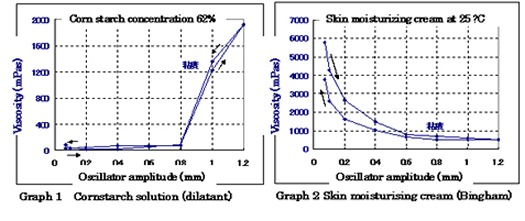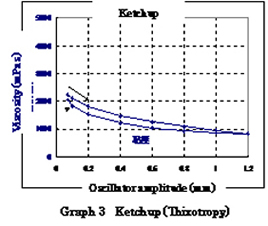Support
Story 19: Tuning-fork Vibration Rheometer: Development of the RV-10000
- RV Series
September 10, 2012
Tuning-fork Vibration Rheometer: Development of the RV-10000
Naoto Izumo
R&D Division 5, A&D Company, Limited
Our tuning-fork vibration rheometer was first introduced to the market in September this year at the Japan Analytical Scientific Instruments Show (JASIS) 2012. As I have previously written about tuning-fork vibration viscometers, they were incorporated two years ago as one of the standards in measuring viscosity in the first such revision to Japanese industrial standards in 19 years (JISZ8803), and have also already been accredited as a viscometer subject to calibration by the Japan Calibration Service System (JCSS).
When our viscometer was first released for sale eight years ago, we received many requests from customers who wanted to know the value of the "shear rate", or be able to adjust it in their measurements. In response, we did not change the natural frequency of the 30Hz oscillators, but instead set about changing the oscillation amplitude by developing a new rheometer: our new RV-10000 model.
Presently, almost all rheometers are rotary type devices. The main features of rotary-type rheometers are a great level of control over the variation width of the shear rate by changing the rotation frequency, and being able to apply the shear rate uniformly to the sample through configuration of the rotor. On the other hand, a lot of energy is required to rotate the rheometer and the state of the sample may be altered from that of before rotation, skewing the measurement. Liquids with low viscosity can often be displaced by the centrifugal force from rotations and problems with repeatability can also occur with rotary rheometers.
With the rheometer developed from the vibration viscometer with adjustable shear rate, the shear rate is varied by changing the amplitude of the oscillating sensor plates. The shear rate can be adjusted even by changing the frequency of vibration, but the vibrating tuning-fork type device increases sensitivity through sharp resonance phenomena and is inviting a reduction of sensitivity if the oscillation frequency is changed. Therefore the oscillation amplitude was made adjustable, rather than the frequency.
As a result, the maximum displacement between the peaks and troughs of the oscillating sine curve motion forms a range of between 0.07mm?1.2mm, focusing around 0.4mm on the viscometer. Results for shear rate at that time can be gained for Newtonian fluids within an approximate 10/sec to 1000/sec range.
For a vibration viscometer, similarly to a rotational-vibration rheometer, the shear rate constantly changes. Therefore, the displacement per unit time is expressed by the root mean square of one cycle. Also, with the vibration type viscometer there is no precise opposite surface to define shear rate. So from the known viscosity of a set liquid, such as water or a Japanese viscosity standard solution, and the "shear stress" calculated by dividing the drive force of the oscillators required to measure that viscosity by the area of the wetted surface the shear rate is obtained.
While it is just a personal opinion, even with rotary type viscometers with a cone-plate that geometrically has a fixed opposing surface (E type), there is no guarantee that the shear rate between opposing surfaces is maintained at a constant value. In other words, even if you logically apply a fixed shear rate to the area filled up with the liquid, depending on the quality of the material of the plate and the sample to be measured, or the condition of the surface of the sample, issues like "slide" or "adhesion" may occur at the interface between the plate and the sample. As a result, there will not be a uniform laminar flow in a depth wise direction, and possibly no linear shear rate applied. Moreover, with non-Newtonian fluids, I am guessing that as well as their particular non-linear characteristic related to the shear rate attributable to the sample material there is also a damping of the shear rate, with these effects having an influence on the measured viscosity.
The definition of viscosity as the relative motion of two parallel plates is quite unambiguous, however when it comes to actually putting this test into practice many problems can arise, such as the effect of the plate edge or theorizing how the plate will actually move in the experiment. Even with rotary type devices, some problems can be faced, such as the behavior of the liquid to centrifugal force around the periphery.
For the thoughts of our company regarding the shear rate of the tuning-fork vibration viscometer or rheometer, please refer to our website for reports from academic conferences or for technical data.
I hope you would excuse my rather long preamble, but we have obtained rather interesting data by measuring the viscosity of various liquids while changing the shear rate of the tuning-fork vibration rheometer. This includes some interesting topics such as why it is possible to run over a water solution of corn starch or potato starch (dilatants); the behavior of Bingham fluids of reducing their viscosity in response to an increase in shear rate; and the thixotropic properties of ketchup, where it is at first hard to squeeze out and then later starts to flow too quickly. Our results show you can undoubtedly measure the behavior of such non-Newtonian liquids as these quite easily now with our new rheometer.
I will not provide a detailed explanation of the results here, but hopefully the three graphs below will clearly demonstrate the measurement data.


Graph 1 demonstrates a sharp increase in the viscosity of a 62% cornstarch solution when a certain vibration amplitude (shear rate) is applied. In Graphs 2 and 3, the characteristic features of a Bingham fluid or thixotropic fluid are confirmed in hand cream and ketchup respectively.
I would also like to share with you a personal aside regarding the development of the rheometer and tuning-fork vibration viscometer. 32 years ago, while working towards my university graduation project, I studied at the Biomacromolecular Physics Laboratory of Riken Research in Wako City, near Tokyo, for just over a year. The director of the laboratory at that time was Professor Eiichi Fukada, who would later go on to become the head of Riken Research. At the time, I'm rather ashamed to admit but I was quite obsessed with mountain climbing and did not put much effort into my studies.
After graduating, I changed jobs a few times before finally arriving at A&D. During the first 15 years or so, I was responsible for the development of some of our electric scales and balances. Later, I developed our tuning-fork vibration viscometer, and this time around our rheometer.
While developing this rheometer, I paid a visit for the first time in 30 years to my previous advisers now working at the Kobayashi Institute of Physical Research, Professors Munehiro Date, Eiichi Fukada and Takeo Furukawa, for some technical advice. When I heard for the first time from Professor Fukada that a long time ago he too had been involved in the test production of a vibration viscometer I couldn't quite believe my ears. Shortly after, he sent me the research paper from that trial. As it turns out, that paper related to the theoretical development and actual measurement data of a vibration viscometer nearly 60 years ago! It was from research Professor Fukada conducted in his early 30s, around the time I was born. I was incredibly surprised to read that the content of the paper was virtually identical to the research we had been doing in the development of our own tuning-fork vibration viscometer. It also felt extremely fateful that these events of 60 years ago, and studying under Professor Fukada 30 years ago, should come together for the development of our new version.
For a long time, rheometers were essentially conceived of as a rotary type device. However, there is now a need for several types of measurements which are extremely challenging for a rotary rheometer, such as viscosity measurements with minimum changes to the physical properties of a liquid, a hysteresis measurement of viscosity caused by changes in the shear rate over a short period, measuring the viscosity behavior of a liquid due to change in temperature, time-dependent change and so forth.
With the development of this new tuning-fork vibration rheometer I believe it has now become possible to actually measure the physical properties of liquids in such manners. The establishment of a new method of measurement like this will bring new precision to experiment results and often contribute to new discoveries and inventions.
It came to our knowledge almost incidentally that a high level of research on vibration viscometers has been conducted in Japan for such a long time. With this historical background in Japan, and Japan's position as the birthplace of the tuning-fork vibration rheometer, we hope that it will prove a very effective measurement device for evaluating the physical properties of liquids and will find many uses across several fields from now.